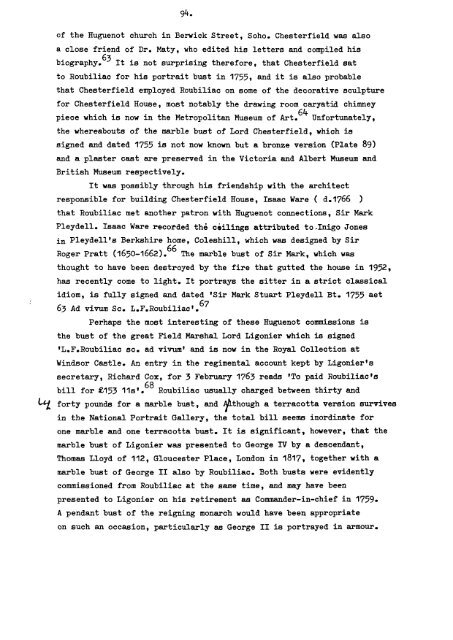HUGIJENOT ARTISTS DESIGNERS AND CRAYPSNEN IN GREAT ...
HUGIJENOT ARTISTS DESIGNERS AND CRAYPSNEN IN GREAT ...
HUGIJENOT ARTISTS DESIGNERS AND CRAYPSNEN IN GREAT ...
Create successful ePaper yourself
Turn your PDF publications into a flip-book with our unique Google optimized e-Paper software.
9k.<br />
of the Huguenot church in Berwick Street, Soho. Chesterfield was also<br />
a close friend of Dr. Maty, who edited his letters and compiled his<br />
63<br />
biography. It is not surprising therefore, that Chesterfield sat<br />
to Roubiliac for his portrait bust in 1755, and it is also probable<br />
that Chesterfield employed Roubiliac on some of the decorative sculpture<br />
for Chesterfield House, most notably the drawing room caryatid chimney<br />
piece which is now in the Metropolitan Museum of Art. 6 Unfortunately,<br />
the whereabouts of the marble bust of Lord Chesterfield, which is<br />
signed and dated 1755 is not now known but a bronze version (Plate 89)<br />
and a plaster cast are preserved in the Victoria and Albert Museum and<br />
British Museum respectively.<br />
It was possibly through his friendship with the architect<br />
responsible for building Chesterfield House, Isaac Ware ( d.1766 )<br />
that Roubiliac met another patron with Huguenot connections, Sir Mark<br />
Pleydell. Isaac Ware recorded the ceilings attributed to-.Inigo Jones<br />
in Pleydell's Berkshire home, Coleshill, which was designed by Sir<br />
Roger Pratt (1650_1662).66 The marble bust of Sir Mark, which was<br />
thought to have been destroyed by the fire that gutted the house in 1952,<br />
has recently come to light. It portrays the sitter in a strict classical<br />
idiom, is fully signed and dated 'Sir Mark Stuart Pleydell Bt. 1755 aet<br />
63 Ad vivum Sc. L.F.Roubiliac'.6<br />
Perhaps the most interesting of these Huguenot commissions is<br />
the bust of the great Field Marshal Lord Ligonier which is signed<br />
'L.F.Roubiliac sc. ad vivuin' and is now in the Royal Collection at<br />
Windsor Castle. An entry in the regimental account kept by Ligonier's<br />
secretary, Richard Cox, for 3 February 1763 reads 'To paid Roubiliac's<br />
bill for £153<br />
Roubiliac usually charged between thirty and<br />
forty pounds for a marble bust, and though a terracotta version survives<br />
in the National Portrait Gallery, the total bill seems inordinate for<br />
one marble and one terracotta bust. It is significant, however, that the<br />
marble bust of Ligonier was presented to George IV by a descendant,<br />
Thomas Lloyd of 112, Gloucester Place, London in 1817, together with a<br />
marble bust of George II also by Roubiliac. Both busts were evidently<br />
commissioned from Roubiliac at the same time, and may have been<br />
presented to Ligonier on his retirement as Commander-in-chief in 1759.<br />
A pendant bust of the reigning monarch would have been appropriate<br />
on such an occasion, particularly as George II is portrayed in armour.
















